Fiona Docherty switches focus to running
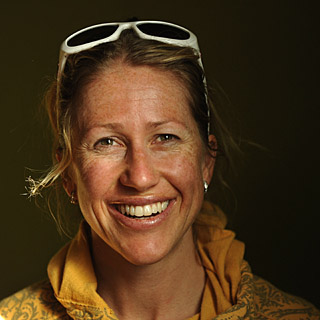
Last summer, Fiona Docherty ran quietly past everyone in the field but soon-to-be-Ironman 70.3 World Champion Joanna Zeiger at the Boulder 5430 long course triathlon.
The New Zealander of Scottish heritage had a perfectly efficient marathoner’s stride, her feet clearing just a fraction of an inch above the dirt path around Boulder Reservoir. The stride was in no way a track sprinter’s gallop. Instead it was an understated, sewing machine-style footfall. With rapid turnover, no drama, and no wasted energy, Docherty cruised through a race-best 1:22:18 run – seven minutes faster than Zeiger – to pull within four minutes of the overall win.
Not quite back to her peak form of 2003, but encouragingly swift.
The Boulder 5430 long course marked the unfinished crest of Docherty’s hard-won comeback from a piriformis syndrome operation two and a half years ago. Going into Ironman Hawaii two months later, Docherty had sharpened her once lagging swim and had high hopes she could recall her world championship performance at the 2003 edition of at Powerman Zofingen, duathlon’s long course equivalent of Kona.
It would have been nice to step out of the shadows of injury. Confident in her improving form, Docherty envisioned a strong swim and bike that would put her in contention and allow her to unleash one of the fastest runs in the sport. And, two years after her career was caught in the shadows interrupted with a frustrating, emotionally draining injury, a strong finish at Kona might allow her to bask once again in a similar sunny spotlight that shined on her brother Bevan with his win at the 2004 ITU World Championship, silvers at the 2004 Olympics, 2006 Commonwealth Games and 2008 ITU Worlds, and the bronze he would earn later that month at the Beijing Olympics.
But a debilitating iron deficiency, diagnosed just a week before Hawaii, left Fiona Docherty not with redemption, but a discouraging DNF. After her long fight back to regain form, it was a bitter pill that made her rethink her sporting goals.
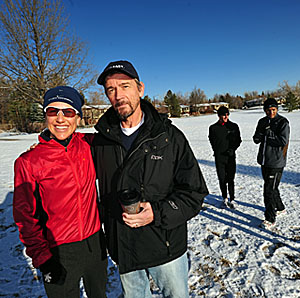
Beginning a new chapter
Early in December, she decided to park her bike in the garage and leave her swim suit packed in the gym bag. She called Boulder-based running coach and former marathon world record holder Steve Jones and asked to join his training squad. Soon she was reborn as a humble runner; suiting up for early morning runs in Boulder ice and snow.
“After Hawaii, I had a bad race and felt I needed a break from triathlon,” said Docherty. “I’d been struggling, having a bad time physically and financially. I’d always wanted to give marathon a good go, and I’d been putting it on hold. So I thought this was my chance. I wanted a life outside sport, which you can’t have training for Ironman. With running, you can have enough energy left over to work and have a personal life.”
And to spark her change of course, Fiona is taking aim at a series of very ambitious targets: Qualify for the New Zealand women’s marathon team for the 2010 Commonwealth Games. Then, the London Olympics.
It is a daring dream. While she had been one of the best runners in multisport, her 1:19 PR half marathon at Eagleman in 2003 would not even get her into the elite running game. If she succeeds, Fiona Docherty will be trying to follow in the footsteps of New Zealand running legend Lorraine Moller, who won an Olympic marathon bronze in Barcelona at the age of 41, and Kiwi multisport legend Erin Baker, who won the first ITU World short course World Championship, two Hawaii Ironman wins and a 2:33:49m PR at the 1992 Los Angeles Marathon.
Three months after signing on with Jones, Docherty faced her first test – a half marathon in Austin, Texas against a top international field. Docherty’s goal? To meet the New Zealand Commonwealth Games rigorous qualifying standard of 1 hour 15 minutes.
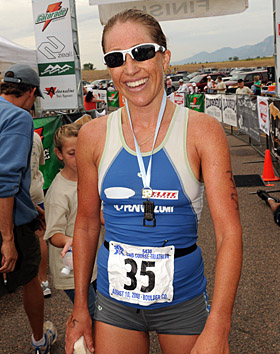
A first world title in 2003
Just six years ago, Docherty stood on the verge of multisport stardom. She gained a world title just a year ahead of her soon-to-be-superstar younger brother Bevan with a rousing win at her first try at the Powerman Duathlon World Championship at fabled Zofingen, Switzerland. Coming off the 2003 ITU Duathlon short course world championships where she broke out front too early and faded from first to 6th, Fiona was advised by Bevan to have more patience in the long course. She played her cards well at Zofingen that September, and ran down Hungarian star Erika Csomor 2 kilometers from the finish for the win.
“It didn't sink in how big this race actually was and what it meant to come in as a dark horse and win it on my first go,” said Docherty. “Then the race organizers gave me a book about the history of the race. Looking20back at the previous winners, it was amazing to see who’d won – Paula Newby-Fraser, Erin Baker(2), Maddie Tormoen (2), Natascha Badmann(3), Lori Bowden, Karin Thuerig(2).”
While Docherty never made it back to Zofingen, her late race pass of Csomor takes on greater significance in retrospect. Since 2003, Csomor has been undefeated in the Swiss classic, exceeding Badmann’s record three victories with her fourth win last year at long course duathlon’s equivalent of Ironman Hawaii. And, at Quelle Challenge Roth last year, Csomor’s runner-up finish was the second fastest Ironman-distance time in history.
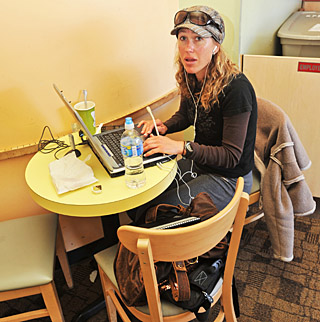
After her Zofingen win, Docherty had several lessons to learn
Inspired by her brother’s second place finish at the Athens Olympics, Fiona went to a half Ironman in London and finished third. Then she went to Lourdes, the home of the grotto of Massabielle, whose spring waters attract thousands of pilgrims annually for their legendarily curative powers, to train for the Nice International Triathlon. Lourdes is in the Pyrenees, on a common Tour de France stage route replete with steep hills, where her brother and fellow Kiwi Hamish Carter trained for their 1-2 Olympic finish. “I stayed there with Yves Tabarant and his wife," she recalled, I also trained with Yves, a good friend of my brother. Then, when I arrived in Nice I trained on the steep hills.”
All the work made Docherty ready. She emerged from the swim with future Ironman 70.3 World Champion Mirinda Carfrae, who promptly took off on the bike for her first major long course win. “I think I gained back on the run, but not enough to win,” said Docherty, who took second. Encouraged by her good performance at the three-quarters–of-an-Ironman distance race at Nice, Docherty signed on for her first Ironman at Western Australia late in the year.
Everything went well – except, as Docherty recalls, “the bike was so flat, the field was big, and it was crowded into three loops. So I got caught up drafting and got a five minute penalty and lost by 4 minutes. I was very happy I went under 9:30.” Docherty crossed the line third, but initial winner Rebekah Keat tested positive for a performance-enhancing substance (a charge Keat vigorously challenged in the courts), and Docherty was bumped up to second.
“From there on I knew I could do well at Ironman," she said. "But unfortunately I've had lots of learning curves with my Ironman races.”
In 2005, she was primed for Ironman Lake Placid but drank too much water the week before and suffered hyponatremia on race day, saw stars on the run and pulled out. At Ironman Canada, she came off the bike third. But she ate and drank too much and had a disappointing run.
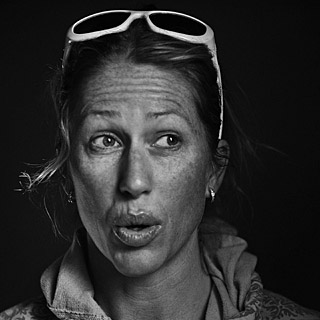
The piriformis detour
Late in 2005, while training for Ironman New Zealand, Docherty ran into the biggest injury of her career. “After doing loads of training on the bike, I started feeling something going on in my piriformis near the sciatic nerve,” she said. “I could not figure out what it was. I was injured, but I was trying not to think that it was. In the race, I lost all power in that leg, and so I had my worst bike ever, especially in the windy conditions. Then I had a decent run – it didn’t affect me much. But even though winds canceled the swim and cut the race down to a half-distance duathlon, I finished 5th or 6th in a race I should have contended for the win.”
After that race, the full extent of the injury hit hard. “We didn’t know what it was at first,” she said. “I was getting pins and needles and all sorts of shocking sensations down my leg. It was so sore and sensitive, I couldn’t even wear pants, so I’d have to just lie on my back. It was so annoying. For a long time, nobody could diagnose the problem. They originally thought it was a slipped disk or something to do with my back.”
Abruptly snapped out of her thriving career and the daily physical challenge she had grown to love, Docherty was miserable.
“It was awful,” she recalls. “I was in this massive depressed state. You are doing well and all of a sudden it is all stripped from you. I felt lonely, like I wasn’t getting anywhere. I hated life basically. I didn’t want to be around people. I treated my parents awfully. I pretty much ignored them. I went all quiet. I just didn’t what to do anything. I’d be a mess. Crying. Especially when I didn’t know what was up.”
Her friends stuck with her. “They were wonderful,” said Docherty. “They put up with a lot, too. They knew I was so down but they were always there. That is the great thing about parents, family and true friends. They were great even though I was trying to shut them out and tried to deal with it myself.”
There were some moments when the contrast between her plight and her brother’s good fortune seemed stark. ”I was just thinking: ‘Oh Bevan’s got this wonderful life. Everything seems to be going well for him. He is making money and I’m not.’ I’d done well after Zofingen. But unfortunately I got injured and then everything goes out the back door and you start losing sponsors.”
Docherty consulted doctors in Auckland and Australia. Unable to ply her trade, she received some New Zealand disability benefits. Finally, former elite New Zealand duathlete, Dr. Matt Brick, cracked the mystery. “It's called piriformis syndrome,” said Docherty. (The piriformis is a flat pyramid-shaped muscle lying almost parallel with the back of the gluteus medius, located partly within the pelvis and partly at the back of the hip joint). Docherty's piriformis was clenched and touching the sciatic nerve. "I had pain shooting down from the butt down to my ankle," she said, wincing at the memory.
"Dr. Brick said her options were surgery – which is not 100 percent — or else just stop doing triathlon," she said. "I wasn't ready for that. Might as well take the risk.” Docherty talks about it casually, but the surgery and recovery were extremely painful. “They just go in there and slice through layers of muscle to get to the piriformis,” she said.
Brick counseled patience. “I can’t tell you how long recovery will be, because it’s not a common surgery,” he told her.” You might start back training in two weeks. Or it might be longer.’”
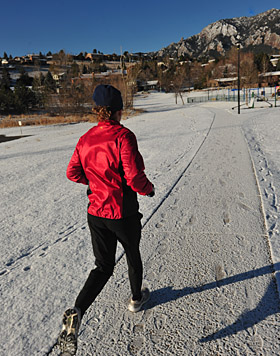
The long road back
Docherty was back in the pool in two weeks, but it was too soon. “I’d have a good week, then it would flare up again and I had to stop," she said. "I slept on my brother’s couch in Auckland, but I should have had someone to bring me home to my mom and dad’s place in Taupo straightaway. I was on crutches, my butt was all stitched up, and I was hurting.”
The operation was in June 2006 and she wasn’t ready to train until 2007. “Scar tissue had built up, so Dr. Brick, who has good knowledge of biking, helped me with bike position," she said. "He started me with a more comfortable position so I could start rehab. Then he altered it as it got better.”
Docherty raced the Auckland half Ironman distance event in March of 2007 and took third, but she still faced setbacks. “The whole side where the surgery was done was just so weak,” she said. “In the middle of the summer, I was thinking my bike was still not right.”
She started doing one-legged exercises on the bike trainer and special muscle work on the affected side. “Basically my piriformis muscle was reduced in size after the surgery, and you can’t make it do the same workload as before,” Docherty said. “I didn't realize that. So I was working with this physical therapist and trying to strengthen it. But it was too aggressive for me and it was pinching again and doing crazy stuff. I had to get cortisone to heal it because I was in pain again. I had the injection and after a couple weeks, I didn't think it was working. Then, Boom! It was better again.”
With her piriformis finally pain-free, 2008 was a long, gradual climb back to form. “When I finally came back after the injury, I was pretty happy,” she says. “I allowed myself a year to give triathlon a good go.”
She started with a 6th at Ironman New Zealand and a 7th at the unfamiliar (and scary, given her injury) off road terrain at XTerra Rotorua. Then she moved to Boulder and got a string of 4th place finishes at Columbia, the Philadelphia Triathlon, and Eagleman 70.3. Finally she earned a podium at the Lake Stevens half Ironman distance event. She knew things were improving because she posted the fastest run at every race. But her 1:25 half marathon at Eagleman – six minutes off her 2003 best – was a sign she still had a ways to go.
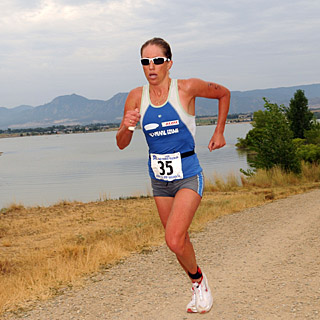
A promising first blooding to her new run career
On a hilly course at the 3M Half Marathon in Austin this January, Docherty finished 8th in a tough international field in 1:15:56 at a pace of 5:48 per mile. “Her time was very encouraging,” said Jones. “She got top 10 in a very competitive road race. For someone who is not part of the road circuit, that was a great blooding. It indicates she has a great chance of going where she wants to go.”
Jones is hesitant to make predictions based on one race, but when pressed said that her first half marathon indicated that “2:44 to 2:45 would be close to the assumption where she might be right now." That estimate is not faster because she lacks the experience of running at that fast a pace for that length of time.” Docherty’s main goal for 2009 is to run the Chicago Marathon this October for a benchmark time to signal if she has a realistic chance to make an Olympic qualifying time. “Right now, everything is a positive for her,” said Jones. “She trained hard, had a good result, and will of necessity train the next four or five months with the group. Her half marathon was an evenly paced race, which indicates the strength she brings from Ironman. I do not put it past her to run a low 2:40 marathon in Chicago.”
Docherty emerged from Austin cheered not so much by the 8th place finish nor her $150 paycheck, nor for coming within 4:39 of the highly-ranked Kenyan women’s winning time, but by meeting Athletics New Zealand's minimum qualifying standard for the half marathon to be eligible for a shot at the New Zealand Commonwealth Games marathon team.
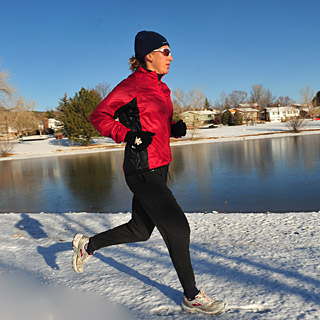
Still a long way to go
“Right now she is far away from her goal,” said Jones. “Not a million miles away, but not 26.2 miles away from it, either.”
The facts are that the New Zealand Olympioc selectors' philosophy is to support only those athletes who have realistic hope of medaling at the big championships. The selectors often don’t look for reasons to choose an athlete for their Olympic teams. Instead, they look for reasons to keep athletes off. The best example of this attitude is the case of marathoner Liza Hunter-Galvan. Despite an internationally impressive 2:30:40 career best at the 2007 Amsterdam Marathon, three minutes under the Athletics New Zealand qualifying standard, selectors initially turned her down for a spot at the Beijing Games. They invoked a clause in their charter that weighs factors such as (poor) performances at past events. Held against Hunter-Galvan was her disappointing 51st place finish in 2:50:23 at the Athens Olympic marathon, on a boiling hot day that left world number one Paula Radcliffe a DNF and several other elites thrashed and trashed. Hunter-Galvan appealed, and after two weeks of hearings, made the team.
At Beijing, Hunter-Galvan ran a respectable 2:34:51 and finished 35th, eight minutes back of winner Constantina Tomescu of Romania. National hero Lorraine Moller, admittedly on a hillier course on a hotter day, won Olympic bronze at Barcelona in 1992 in 2:33:59, 78 seconds out of gold. Moller had run better, 2:28:54, at the 1984 Olympics but finished 5th.
All this goes to show that in all likelihood, to make the New Zealand women's marathon team for the London Olympic Games, Docherty must at least meet the 2:33 standard, which is a 5:52 per mile pace for 26.2 miles. Her 2009 Austin mark, a decent start, was only 4 second per mile faster at half the distance.
Even the great Erin Baker had Olympic dreams of qualifying in the 10,000 (as Canadian multisport star Carol Montgomery did in 2000), but fell short. With a 2:33 personal best in 1992, Baker might have had a better shot at the marathon. Certainly she had confidence – in one interview she declared she was capable of a 2:26 at the distance. But ultimately she never proved it, probably because she never dropped her money-making ace in the hole, her triathlon career, to focus solely on running.
Given her 2003 Powerman world title at Zofingen, Fiona appears to be cut from similar cloth as brother Bevan, who is one of the three or four best runners in Olympic triathlon. But Bevan's 28 flat 10km best is another indicator that multisport athletes must specialize to meet the unforgiving single-sport Olympic standards.
While her lost two years due to piriformis injury were certainly frustrating, they might have been a blessing in disguise, leaving more fresh miles on her running odometer – if she can remain healthy. When Docherty returned from Austin with a sore Achilles and had to lay off hills and longer runs for a while to recover, Coach Jones was not worried. “From what I’ve observed her past piriformis troubles have no effect now on her stride. I would say the piriformis has more effect on the bike than the run. As for the Achilles, I think it is just common niggles you get from more consistent intervals, hill running and distance work – than she gets with Ironman training."
Right now, Docherty is running with a squad of Jones' runners in which most women run the 5k in the range of 19 minutes. Jones’ elite group includes internationally experienced Eduardo and Jorge Torres, and 2004 Olympian Shayne Culpepper, whose 5km PR is 15:01. “Hopefully some day Fiona will graduate to that group,” says Jones.
While happy in her current focus on running, Docherty hasn’t completely abandoned triathlon. “Don’t get me wrong,” she says. “I do love triathlon and I will come back to it. I know I have a good Hawaii Ironman in me. For the meantime, I enjoy straight running. I love the fact that when I travel all I have to do is take my running shoes and running gear. It’s so simple. I’m more relaxed. Before the half, I was so relaxed because I don’t have to organize all the stuff. With more time on my hands to enjoy life, I can spend more of it with friends and family.”

